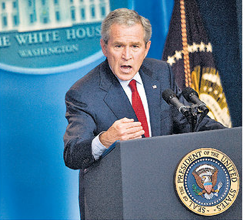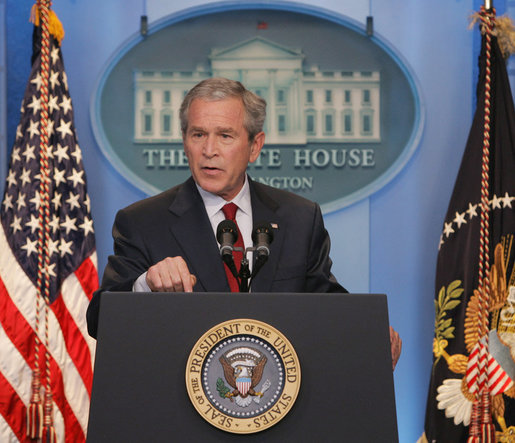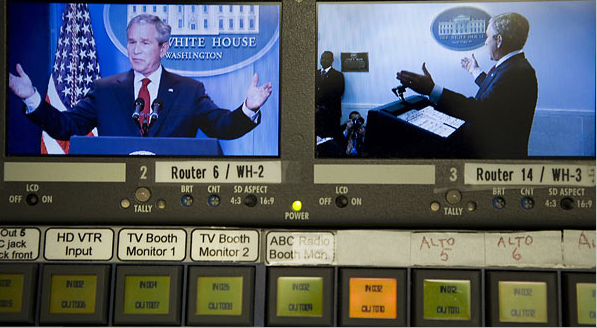There is no king in the United States, or at least so we are taught in our high school civics classes (or at least we were taught that back “in the day” when we actually taught civics in high school). Nevertheless, there has always been something of a courtly attitude towards the presidency, a certain reverence to how we represent the commander-in-chief in the public culture, especially during times of war – or at least in the official public culture, satire and parody notwithstanding. And part of this courtly attitude is something of an unstated agreement between the media and the American people that we will make believe that representations of the president are “real” in a more or less direct, window-on-the-world sort of way. We all know that the White House press corps has its own version of the paparazzi that follow the president around, and that many if not most of the images we see of him are a part of photo opportunities that belie a certain unstated complicity between the administration and the media, but we have come to accept that as part of doing business. After all, the press corps need the pictures to drive their visual medium, the White House needs to have itself shown doing the business of government, and the American people crave the sight of those in power. And so we all try to ignore the staged, theatrical, performed quality of events with a wink and a nod.
Today’s New York Times seems to manage the constraints of this unstated agreement in a somewhat complex and interesting way. The front page headline reads, “A Firm Bush Tells Congress Not to Dictate War’s Policy” and the photograph that is featured on the front page seems to make the point:
Strong, decisivie, resolute, the imprimatur of the White House behind him, the presidential seal in front, he is the very picture of a commander-in-chief. And it is not at all unlike a very similar photograph that graces the corresponding story on the White House website for July 13th, reporting the same speech:
The media and White House are thus in perfect synchrony.
But when we turn to the on-line version of the NYT story we get a different “picture” of the event:
The headline, which appears directly above the photograph, is the same as in the paper version: “A Firm Bush Tells Congress …” But here the caption beneath the photo seems incongrous with the headline, almost a visual non sequitur: “Images of President Bush were fed through an audio-visual console for editing during his White House news conference Thursday on changes in Iraq.”
A couple of things seem notable here. First, there is NO mention of the photograph or what it might illustrate in the story by Sheryl Gay Stolberg and Jeff Zeleny. Hence, it seems added on, a gratuity serving no real or direct information value. But at the same time, of course, it calls direct attention to the mediated quality of the image and to the performative nature of the event. This is not the “real” president we are seeing (as if we ever “really” do see him in some unmediated, unedited, fashion), but a version that is processed through a complex technology of almost total control. And last, it is left somewhat ambiguous as to who owns the console and who will do the editing, but there is at least the hint that it is the White House and not the networks who are in control. And in any case, this clearly does not look like the picture of a “A Firm Bush” telling anybody anything, but rather someone telling the tale of how “the big got away.”
And so we have here an image that suggests not only that the original picture is something of a “fib” – because that’s what fish stories are about, not out and out lies, but self-aggrandizing exaggerations – but that it is also completely and totally manufactured, a performance calculated as to its effect and controlled by someone standing behind the curtain. And, of course, the photograph on the NYT website stands in stark contrast to the image of the regally clothed, firm, and resolute president we see on the front page of the paper version and at the White House website. By casting it all as a fib the NYT does not go completely out of bounds in attacking the president, and so it stays more or less true to the spirit of the unstated agreement to honor some sort of decorum. After all, the president is not a king, but the “first among equals,” and we all do tell fibs. And yet, at the same time, it seems pretty clear that someone is shouting at us that “the Emperor is naked”!
Photo Credits: Brendan Smialowski/New York Times, Chris Greenburg, White House



I was equally struck by the visual double-talk in this image of the a/v console, in which the president is almost incidental…the image and its intriguing caption appear in print not until page 6, where the front page article continues. The image recalls the work of Gary Winogrand, notably his image of JFK at the 1960 convention (viewable, unfortunately not particularly well, at http://www.sindromedistendhal.com/MOSTRAsala5.htm if you scroll down a bit, or see Ch. 3 of David Lubin’s “Shooting Kenney: JFK and the Culture of Images,” p. 102). The photograph shows Kennedy at the podium, take from the back, his hand raised, the Rembrant glow around the outline of the head, but the majesty undermined by a console at the foreground, on which sits a television set broadcasting the speech live. The president’s face is only seen on the screen, which faces the viewer of the photograph, but not the public addressed by the speaking president. Winogrand’s “behind the curtain” view point highlights the mediated nature of seeing public figures and his work in general anticipates the trend of news photographs that also happen to depict or reveal the tools of the trade in the form of cameras, microphones, even whole photographers present within the frame of the photograph. These incidental props become the main attraction in the a/v console photograph of Bush. The caption’s use of the word “fed” (as in “images of Mr. Bush were fed through an audio-visual console”) is also important and reminds us that the images are not just fed through machines but to a mass-consuming public.